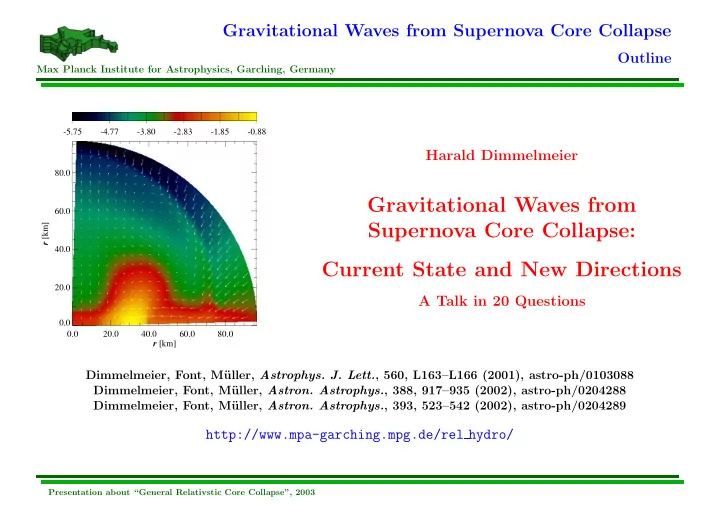

���������������������������������������������������������������������������������������������������������������������������������������������������������������������������������������������������������������������������������������������������������������������������������������������������������������������������������������������������������������������������������������������������� Gravitational Waves from Supernova Core Collapse Outline Max Planck Institute for Astrophysics, Garching, Germany -5.75 -4.77 -3.80 -2.83 -1.85 -0.88 Harald Dimmelmeier 80.0 Gravitational Waves from 60.0 r [km] Supernova Core Collapse: 40.0 Current State and New Directions 20.0 A Talk in 20 Questions 0.0 0.0 20.0 40.0 60.0 80.0 r [km] Dimmelmeier, Font, M¨ uller, Astrophys. J. Lett. , 560, L163–L166 (2001), astro-ph/0103088 Dimmelmeier, Font, M¨ uller, Astron. Astrophys. , 388, 917–935 (2002), astro-ph/0204288 Dimmelmeier, Font, M¨ uller, Astron. Astrophys. , 393, 523–542 (2002), astro-ph/0204289 http://www.mpa-garching.mpg.de/rel hydro/ Presentation about “General Relativstic Core Collapse”, 2003
���������������������������������������������������������������������������������������������������������������������������������������������������������������������������������������������������������������������������������������������������������������������������������������������������������������������������������������������������������������������������������������������������� Gravitational Waves from Supernova Core Collapse Motivation Max Planck Institute for Astrophysics, Garching, Germany What happens in a Supernova Explosion? Physical model of a core collapse supernova: • Massive progenitor star ( M progenitor ≈ 10 − 30 M ⊙ ) develops a core of iron group nuclei. • When core exceeds Chandrasekhar mass ( M core ≈ 1 . 5 M ⊙ ), it collapses ( T collapse ≈ 100 ms). • At supernuclear density, EoS of matter stiffens ⇒ bounce, hot proto-neutron star forms. → Gravitational waves − • Hydrodynamic shock propagates outward from sonic sphere, but stalls at R stall ≈ 300 km. • Proto-neutron star cools, collapse energy is released by neutrino emission ( T ν ≈ 1 s). • Neutrinos deposit energy behind stalled shock and revive it (delayed explosion mechanism). → Gravitational waves − • Shock wave propagates through stellar envelope and disrupts rest of star (visible explosion). • Neutron star may develop triaxial instabilities due to gravitational wave backreaction. → Gravitational waves − Presentation about “General Relativstic Core Collapse”, 2003
���������������������������������������������������������������������������������������������������������������������������������������������������������������������������������������������������������������������������������������������������������������������������������������������������������������������������������������������������������������������������������������������������� Gravitational Waves from Supernova Core Collapse Motivation Max Planck Institute for Astrophysics, Garching, Germany Why are Gravitational Waves from Supernovæ so interesting? Conventional means of observing supernovæ: • Optical light emission: Hours after actual collapse; emitted from stellar surface; no direct information about collapse engine. • Neutrinos from core bounce: Directly from engine region; flux decays like 1 /r 2 ; extremely low detectability (for SN 1987A: only ∼ 10 neutrinos detected). Gravitational waves can directly probe collapse mechanism! With 1 /r , fall-off behavior is superior to neutrinos. Measurement of signal waveform will reveal new physics! Gravitational waves will put constraints on rotation states of iron core and neutron star, supernuclear EoS, degree of convection, . . . Presentation about “General Relativstic Core Collapse”, 2003
���������������������������������������������������������������������������������������������������������������������������������������������������������������������������������������������������������������������������������������������������������������������������������������������������������������������������������������������������������������������������������������������������� Gravitational Waves from Supernova Core Collapse Observation Max Planck Institute for Astrophysics, Garching, Germany What are the Observational Challenges? Consider: • Wave signal from core collapse supernova is close to interferometer detection limit ( h ≈ 10 − 20 for a Galactic event). • A burst signal is very complex and short in time (has no chirp signal “trigger” like merger burst signal). ⇒ We need realistic prediction of signal from relativistic numerical simulations! Our contribution: Relativistic simulations of rotational core collapse to a neutron star in axisymmetry, and publicly available gravitational wave signal catalogue from a parameter study. Presentation about “General Relativstic Core Collapse”, 2003
Recommend
More recommend